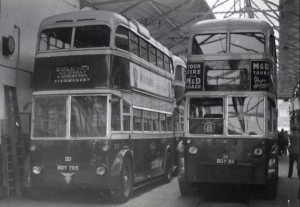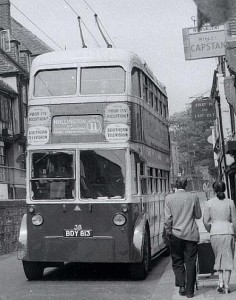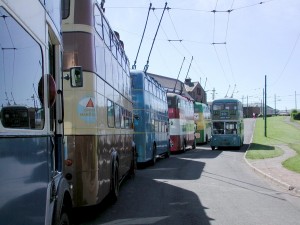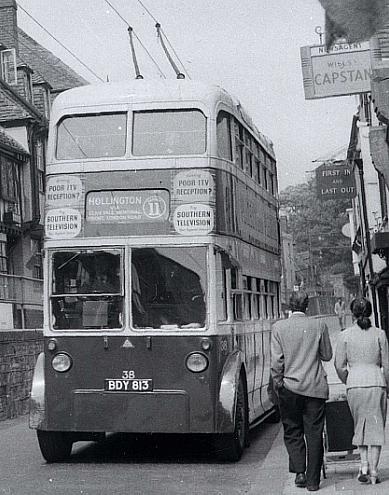Ion Castro of the Hastings Trolleybus Restoration Group explains why.
First of all, what is a trolleybus? Trolleybuses, to all intents and purposes look just like any other bus, except they have a couple of poles sprouting out of the roof to connect with wires suspended above the roadway. The main and significant difference is that they run on electricity and are totally pollution-free! (at point of use anyway) and what’s the difference between trams and trolleybuses?



Trams run on rails, rather like trains really, and many of us will remember seeing pictures of strange double decked contraptions, running through the centre of our towns. Trams were always a good idea, but due to their rails were in conflict with other road users, and as private motor car usage increased and roads became crowded. They became less and less practical because of their perceived inflexibility and the high cost of the infrastructure. On the other hand, trolleybuses were able to manoeuvre more easily within the limit of their overhead trolley poles and didn’t need expensive rails to run on. So what happened to them?
Well, the electric overhead was always considered a drawback to their flexibility and motor buses could run pretty much anywhere and at any time. 60 years ago the impact of all the carbon emissions, global warming and all that, if thought about at all, didn’t seem to matter, particularly as the world had just emerged from a catastrophic world war with its tangible death and destruction made the perception of, “a little bit of pollution”, totally insignificant. It was a time of rationing, export-or-die there was little or no money for infastructure.
Hastings had trolleybuses from 1928 to 1959 and they provided a much loved reliable and frequent service. One of the original trolleybuses from 1928 is still in the town; known as Happy Harold he is looked after by the Hastings Trolleybus Restoration Group. Unfortunately, when trolleybuses came to an end in 1959 he was fitted with one of the noisiest diesel engines on earth (the Commer TS3) so, in his current guise is not a good example of silent pollution-free public transport but he’s still an incredible vehicle and is now 80 years old.
Today, when we are trying to reduce carbon emissions, trolleybuses would provide the ideal solution. The 500 volts required to run the system could be generated by wind power, or wave power. Wave power is an interesting proposition because taking the energy out of the waves would reduce coastal erosion. A novel power source has also been suggested, using the generator unit from a diesel electric train, running on bio diesel or even chip fat is actually quite feasible. Otherwise, electricity can be drawn from the National Grid.
It’s a matter of fact, that trolleybuses use no energy whatsoever when standing still (unless it’s night time and the lights are on or the bus has air conditioning) and it doesn’t matter if the bus is standing still in a bus stop or caught in a traffic jam in an area of poor air quality such as the Bexhill Road in St Leonards. As long ago as the 1930s Guy trolleybuses were famous for their regenerative braking, which put current back into the wires for other buses to use – buses descending the many hills of Hastings or slowing down for bus stops, not only used no electricity at all, but actually put power back for other trolleybuses climbing the hills or pulling away from bus stops! Try that with a diesel bus.
So why is there no national pro-trolleybuses lobby? Why does no-one harangue our elected members? The answer is quite simple, there is no money to be made lobbying for this clean, silent sustainable form of transport – on the other hand there’s lots of money to be made digging up roads to lay rails for a tramway system — it has even been suggested that mile for mile you could install trolleybus infustructure for the same cost as the lobbyists fee for an equivalent tramway. Bus manufacturers don’t need to lobby because it doesn’t matter to them whether they build motor buses all trolleybuses, they may even prefer to build motor buses because they don’t last as long as trolleybuses (electric motors have less vibration, and therefore the bus body lasts longer) and of course there’s the oil companies… Sadly, it appears that service is secondary to profit.
Trolleybus advantages include easier (and therefore cheaper) maintenance – electric motors are simpler, smaller, lighter and last longer than diesel units with the same power output. They are capable of incredible acceleration and are particularly suited for hilly towns. They don’t need a gearbox, lubricating oil, coolant or liquid fuel so weight savings would allow the carriage of an extra 8 passengers for the same all-up vehicle weight.
Putting up wires for trolleybuses shows a commitment to public transport, because it demonstrates permanence. People know that having made the investment in the overhead wiring there will be trolleybuses running under that wiring. Coupled with real-time bus stop mounted route indicators prospective passengers (I suppose these days we would call them customers), would know how long they would have to wait. The trolleybuses service could include the two other Hastings Trolleybuses in preservation (once restoration had been completed), heritage vehicles that formerly ran in other towns in the UK (this would provide a unique tourist attraction) or state-of-the-art purpose-built vehicles, or even converted motor buses. Leeds in Yorkshire is planning to reintroduce trolleybuses in parts of the city where regeneration investment is being made and I am following that with interest.
Experience on the Blackpool tramways indicates that tourists travel the full length of the tramway and attractions along the tramway and its termini benefit considerably — it provides a reason to go to Cooden Beach for example. It would certainly show that there is more to Hastings than the Old Town.
This article will be posted on the Hastings Trolleybus Restoration Group’s web site, www.1066.net/trolley after it has appeared in print in “Hastings Town.
Don’t forget the annual show on the Oval on May 18th, more information about that is also available on the website.
Hastings Town March 2008
All articles, photographs and drawings on this web site are World Copyright Protected. No reproduction for publication without prior arrangement. © World Copyright 2015 Cinque Ports Magazines Rye Ltd., Guinea Hall Lodge Sellindge TN25 6EG
